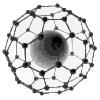DMT-Nexus member
Posts: 47 Joined: 25-Dec-2012 Last visit: 12-Jan-2017
|
Can IPA be used to remove residual petrochemical solvents (e.g. Xylene)?
If the spice was re-dissolved into IPA and gently heated, wouldn't the Xylene technically sit on top of the IPA and evaporate? While all the spice would remain in the IPA.
Then IPA can be evaporated for a Xylene residual-free spice.
Is there anything incorrect about doing this?
|
|
|
|
|

DMT-Nexus member
Posts: 557 Joined: 12-Jul-2012 Last visit: 01-Jan-2021
|
Firstly, xylene is soluble in IPA, it wouldnt float.
The next best thing you'd be hoping for, since xylene boils at a higher temp than IPA, would be an azeotropic mixture that boils lower than either. That doesnt happen either, the IPA would cook off before the xylene (the mix is zeotropic, you can separate them by distillation).
However, IPA does form azeotropes with some non-polars.
IPA boils at 82.45°C
Toluene boils at 110.6°C
Combine them and a mix of 69% IPA and 31% toluene boils off at 80.6°C until one component or another runs out.
IPA azeotropes also work for the aliphatic series- pentane, hexane, heptane, octane, cyclohexane...
So your idea is useful, just not for xylene or mixed solvents containing aromatic compounds.
[Same score with ethanol, it forms azeotropes with aliphatics and toluene but not xylene]
If your library has a CRC handbook of chemistry and physics all this fun stuff is in the "Tables of azeotropes and zeotropes" section
|
|
|

DMT-Nexus member
Posts: 4031 Joined: 28-Jun-2012 Last visit: 05-Mar-2024
|
Would one not loose spice in such boiling off attempts at around 80 deg C?
If yes, slow evaporation at room temp, would work as well?
|
|
|

DMT-Nexus member
Posts: 557 Joined: 12-Jul-2012 Last visit: 01-Jan-2021
|
Loss would probably be trivial unless it was boiled to dryness and then allowed to sublime.
DMT's boiling point is 332.1°C with decomposition. The oft quoted boiling point of 60-80° is when its distilled under hard vacuum (a critical bit of info thats usually ignored).
If DMT did form an azeotrope with IPA we'd have an awesome new tek in the works, lol
|
|
|

DMT-Nexus member
Posts: 4031 Joined: 28-Jun-2012 Last visit: 05-Mar-2024
|
Thank you Auxin.
I heard of the 60-80 vs 332 boiling point, but I invite to bring the aspect of [partial pressure of mixed components and it's influence to the boiling temperature of the components] into all this, as a line of thought. A boiling mixture is no stable lab equilibrium state of a 1 pure compound, was on my mind.
If there exist extreme low concentration of spice in the mixture vapor (leading to areas of extreme low partial pressure of spice there), the spice on the surface right there might behave (boil up) like in a real vacuum, thus at 60 - 80.
(Room temp evap would avoid that.)
I am confident the effect happens, but as you say: would it be trivial in numbers?
|
|
|
DMT-Nexus member
Posts: 47 Joined: 25-Dec-2012 Last visit: 12-Jan-2017
|
Is there a similar way to remove Xylene from pulls?
|